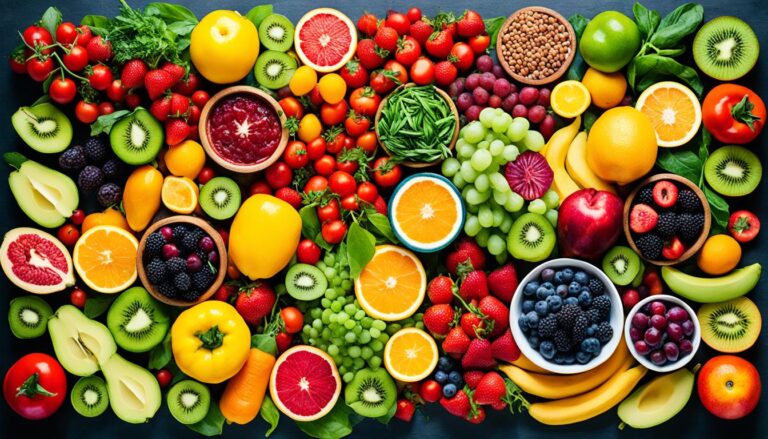Today we ask What if our health depends more on our diet than on new medicines? This idea known as food is medicine FIM is getting a lot of attention.
It’s sparking debates among doctors lawmakers, and everyone else.
For a long time, people have seen food as key to staying healthy. Now, thanks to more research and support this idea is becoming a big part of healthcare talks. We’ll look into why nutrition and health food as preventive medicine, and diet and disease prevention are so popular with those looking for a better way to stay well.
Key Takeaways
- The idea of food is medicine FIM is getting more popular, showing a growing interest in using food in healthcare.
- FIM includes things like special meals and groceries, and even prescriptions for fruits and veggies. It’s all about helping people manage health issues and feel better overall.
- More people are supporting FIM thanks to things like the 2022 White House Conference on Hunger Health, and Nutrition. This has led more states to ask for federal money for FIM programs.
- Some say food is medicine is too simple, but it’s based on a long-held belief that food can heal us and keep us healthy.
- Food companies are excited about FIM but some experts worry about its misuse or wrong use.
What is Food as Medicine?
Food as Medicine FIM is a way to see food as key to health and wellness. It’s an approach that combines nutrition with healthcare to boost well-being. FIM uses food to prevent, manage, and even reverse health issues.
Defining Food as Medicine
FIM believes food is a vital part of healthcare. It gives people the right foods and nutrients they need. This supports both physical and mental health through a holistic wellness plan.
It offers different ways to help like medically tailored meals medically tailored groceries, and produce prescriptions. These programs give the nutrition support people need to stay healthy or get better.

The food as medicine definition highlights how nutritious foods help prevent disease. By adding food-based programs to healthcare FIM helps people take charge of their holistic wellness. It uses nutrition-based interventions to greatly improve health.
Food as Medicine Interventions
The Aspen Institute and Harvard Law School’s Center for Health Law and Policy Innovation have found three main types of Food as Medicine FIM interventions. These are medically tailored meals groceries, and produce prescriptions. They aim to improve health by focusing on what people eat.
Medically Tailored Meals and Groceries
These programs give people meals or groceries that fit their health needs. Doctors often suggest these services. Studies show they can make eating better, improve health knowledge, and boost well-being.
Produce Prescriptions
Produce prescriptions let people buy fruits veggies, and healthy foods with special cards. These programs increase healthy eating, lower BMI, and improve health markers. A review found doctors are more interested in these programs to help patients eat more fruits and veggies.
One in five deaths worldwide is linked to poor diets, more than smoking. These food programs could greatly improve health. They aim to fight the leading cause of death globally.
| Intervention | Key Findings |
|---|---|
| Medically Tailored Meals |
|
| Produce Prescriptions |
|
These studies show how medically tailored meals, medically tailored groceries, and produce prescriptions can help health and save money. They are key in nutrition-based healthcare.

Read more: Benefits of adding high fat foods to meals
Medically Tailored Meals and Groceries
Medically tailored meal delivery and grocery programs are new ways to help people with chronic diseases or food insecurity. They give out meals, meal kits, or groceries that fit their health and diet needs.
For instance people with type 2 diabetes or kidney disease might get meals or groceries to help manage their health. These services help those who struggle to get or make the food they need. This includes people getting cancer treatment or new moms.
These food as medicine programs aim to help people with chronic conditions. They work to prevent health problems and boost well-being. The Food is Medicine Coalition requires one full-time dietitian for every 1,000 clients. This ensures everyone gets personalized nutrition advice.
Also, these groups can’t serve foods with artificial sweeteners, preservatives, or ultra-processed ingredients. This shows their dedication to quality nutrition based treatments. The goal is to make these meals and groceries available to all who need them no matter where they live or their financial situation.
Addressing Food Insecurity and Chronic Conditions
Medically tailored meals and groceries do more than help individual health. Studies show that giving food prescriptions to diabetes patients could save $36.9 billion in healthcare costs. Also offering tailored meals to patients with diet related conditions could prevent 1.6 million hospitalizations and save $13.6 billion a year.
With chronic diseases like diabetes, heart disease, and obesity on the rise, food as medicine could be a key solution. It combines healthcare policy, and community efforts. This movement could change how we handle chronic diseases and nutrition.

The standard has been developed over a year by a committee of agencies across the country alongside SCS Standards and has been approved by the Food is Medicine Coalition’s advisory board.
Produce Prescriptions
Produce prescription programs are a new way to help prevent diet-related diseases and make healthy food more accessible. They give people who struggle with food security or health issues the chance to buy fresh fruits, vegetables, and sometimes other healthy foods. This helps them get the nutrients they need.
These programs tackle several problems at once. They make sure people can afford and get high-quality produce. This leads to better eating habits and can prevent or manage diseases like diabetes, high blood pressure, and obesity.
Many programs also offer cooking classes and nutrition advice to help people use the food well in their daily meals.
Proven Benefits of Produce Prescriptions
- People in these programs see big health improvements, like better blood sugar levels, blood pressure, and weight.
- Food insecurity drops a lot, from 59% to 48%, for those who join these programs.
- Experts think giving produce prescriptions to 6.5 million adults could prevent almost 300,000 heart disease cases and save about $40 billion in healthcare costs.
As we learn more about how food affects our health, produce prescription programs are becoming more popular. They’re seen as a key way to improve health and prevent diet-related diseases. By helping people make better food choices, these programs are changing lives and communities.
Produce prescription programs are a game-changer in the fight against chronic disease. By putting the power of fresh nutritious food in the hands of those who need it most we’re seeing tangible improvements in health outcomes and quality of life.
Why do we say food is medicine?
The saying food is medicine comes from old traditions that see food as a key to healing. It goes back to Hippocrates, an ancient Greek doctor who said, Let food be thy medicine and medicine be thy food. This idea has been a big part of many traditional health beliefs.
But some people think the phrase is too simple suggesting food can replace medicine. Supporters of the food as medicine movement say it highlights a big truth. They believe eating well can help prevent and manage diseases. They think healthcare should use food more in treating patients.
Research now backs up the idea that good nutrition is key to staying healthy. Studies show that special diets can cut down on doctor visits. They also show how food can help with conditions like diabetes and high blood pressure.
As we learn more about the cultural traditions of food the idea of food as healing is becoming more accepted. Now doctors are starting to recommend diet changes as part of treatment. This shows Hippocrates’ ideas about food and health are becoming more popular.

Read more: Top Vitamin B1 Food Sources for a Healthy Diet
Cultural Traditions and Food as Medicine
Many communities worldwide see food as a key part of health. They believe in the power of traditional medicine practices and Indigenous food wisdom. These ideas have been around for a long time.
In traditional Chinese medicine, eating right is key to staying healthy. Indigenous communities also use food to heal and stay well. They rely on their cultural food heritage.
Dismissing the idea of ‘food as medicine’ can be seen as a form of colonial erasure as it denies the validity and importance of these longstanding cultural traditions argues dietitian and poet Lucy Aphramor.
Supporters of FIM say we can learn a lot from these old ways. By doing so we can make healthcare better. This means using food in new ways to keep people healthy and prevent sickness.
- Herbal remedies like Trini Bush Tea which has been used for centuries to treat a variety of ailments
- Nutrient rich traditional foods like fiddlehead ferns, wild rice, and the Three Sisters corn squash, and beans
- Time-honored cooking methods and flavor profiles that support overall well being
By using the wisdom of cultural traditions we can change healthcare for the better. This approach values food’s power to feed both body and spirit.

Read more: Antioxidant Foods Nourish Your Body Naturally
The Rise of Food as Medicine
The idea of Food as Medicine (FIM) is not new, but it’s getting more popular. This is thanks to more funding, policy changes, and the food industry getting involved.
The 2022 White House Conference on Hunger Health, and Nutrition played a big role in this growth. It made more states look into Medicaid funding for FIM programs. They see how food can help improve health and cut healthcare costs.
Companies like Instacart are now working with groups like the American Heart Association. They’re pushing for more research and awareness in FIM. This is making food-based therapies more accepted in healthcare.
These changes in healthcare policy and the food industry’s support have made FIM more well-known. With more money and focus on it food-based treatments are becoming a regular part of healthcare. This could lead to better health for patients and lower healthcare costs.
Every dollar spent on nutritional counseling and medically tailored meals can save up to $50 in healthcare costs.
Drawbacks and Criticisms
The Food as Medicine FIM movement has grown popular, but it also faces criticism. Some worry that too much money is going into FIM taking away from other important health efforts. They point out that giving free school meals or changing food recipes could be more effective.
There are also doubts about the food industry’s support for FIM. Critics believe the industry might use the movement to push its own goals. They think it aims to make people believe diet diseases are their own fault.
Some argue that the food is medicine idea oversimplifies the role of food. It ignores the cultural and emotional value of food. Supporters of FIM say it’s about using food to prevent health problems. They believe it should be part of a complete health plan.
A 2023 study found eating lots of ultra-processed foods can increase the risk of some cancers. This shows the need to be careful with FIM. The food industry’s push for certain diets might not always help public health.
Yet, food’s ability to prevent and treat health issues is still strong. The key is to make sure the food industry’s role in FIM is open and focused on health, not profits.
Food as medicine is a powerful concept, but it must be approached with nuance and a critical eye to ensure it truly serves the best interests of public health.
Food as Preventive Medicine
The idea that food is medicine is becoming more popular. It’s because eating well and staying active can help prevent diseases. By focusing on prevention and using food to help we can take control of our health.
The Power of Plant-Based Nutrition
Eating foods like vegetables, fruits, whole grains, and legumes can prevent many diseases. These foods are full of antioxidants and fiber. They help our bodies fight off illness and reduce inflammation.
Chef Andrea Beaman got rid of her thyroid disease in two years by changing her diet and lifestyle. Chef Maneet Chauhan used food to stay healthy as a child. She ate red carrots and one gooseberry a day for their health benefits.
Integrating Food into Healthcare
More doctors are now using food to help prevent diseases. The Loma Linda University School of Medicine teaches Lifestyle Medicine. This includes using food in treatment plans.
Places like the Therapeutic Food Pantry at Zuckerberg San Francisco General Hospital give out healthy food and teach cooking. Doctors are helping patients make better food choices. This can lead to fewer chronic diseases and a healthier life.
Integrating Food as Medicine
The Food as Medicine FIM movement is growing fast. More healthcare providers are adding food and diet changes to their treatments. This change, known as culinary medicine means doctors and nurses work with patients to make food plans and teach cooking skills. These steps help improve health and well-being.
Healthcare places are seeing the good in FIM too. Some have started rooftop gardens offer special meals, and give cooking classes. By using food in their care doctors can help patients in a deeper way. They look at diet and lifestyle to fight illness and disease.
Embracing Culinary Medicine
Teaching healthcare workers about culinary medicine and nutrition-based treatment is key. This training makes doctors and nurses food experts. They learn to make food plans just for each patient, teach cooking, and find the real reasons for health issues.
- Develop personalized dietary plans tailored to each patient’s unique health needs and preferences
- Teach patients practical cooking techniques and meal preparation skills to support their dietary goals
- Collaborate with patients to identify and address the root causes of their health challenges, including dietary and lifestyle factors
Adding culinary medicine to their work healthcare providers help patients take charge of their health. Food becomes a powerful tool for better health.
| Healthcare Provider Training | Patient-Centered Care |
|---|---|
| Culinary medicine courses | Personalized dietary plans |
| Nutrition-based treatment protocols | Cooking skill development |
| Collaboration with registered dietitians | Addressing root causes of health challenges |
By incorporating food-based interventions into standard care, healthcare providers are able to take a more holistic, patient-centered approach that addresses the underlying dietary and lifestyle factors contributing to illness and disease.
Conclusion
The Food as Medicine FIM movement is changing how we see healthcare and wellness. It shows how food is key to our overall health. This new way of thinking is leading to better care that focuses on the patient.
With the rise of chronic diseases and high healthcare costs FIM’s benefits are clear. It offers tailored meals and grocery options that help improve health and cut costs. Research proves that what we eat affects our health and managing chronic diseases.
Healthcare workers, policymakers, and anyone wanting better health take note: food is more than just food. It’s a key part of staying well. By changing our eating habits, we can use Food as Medicine to make a big difference. This can lead to a healthier future for everyone.





